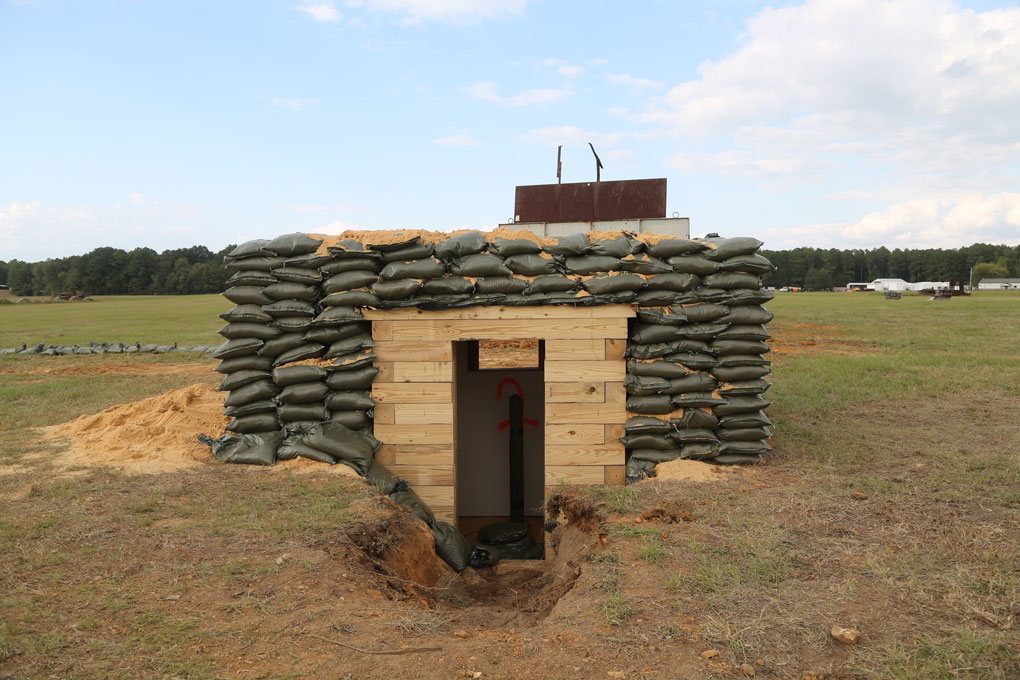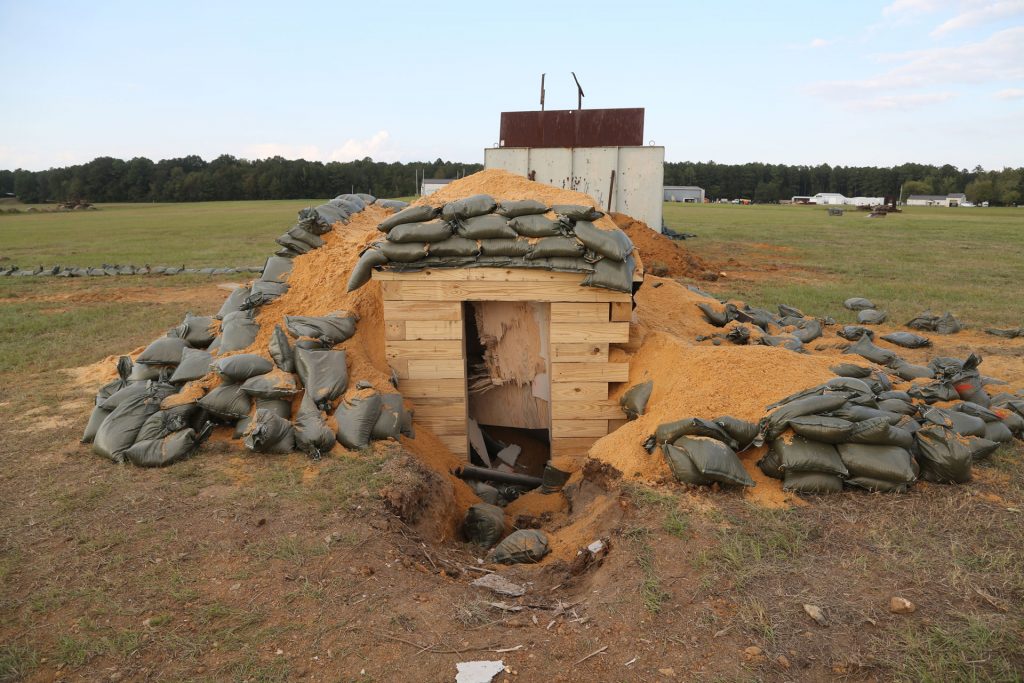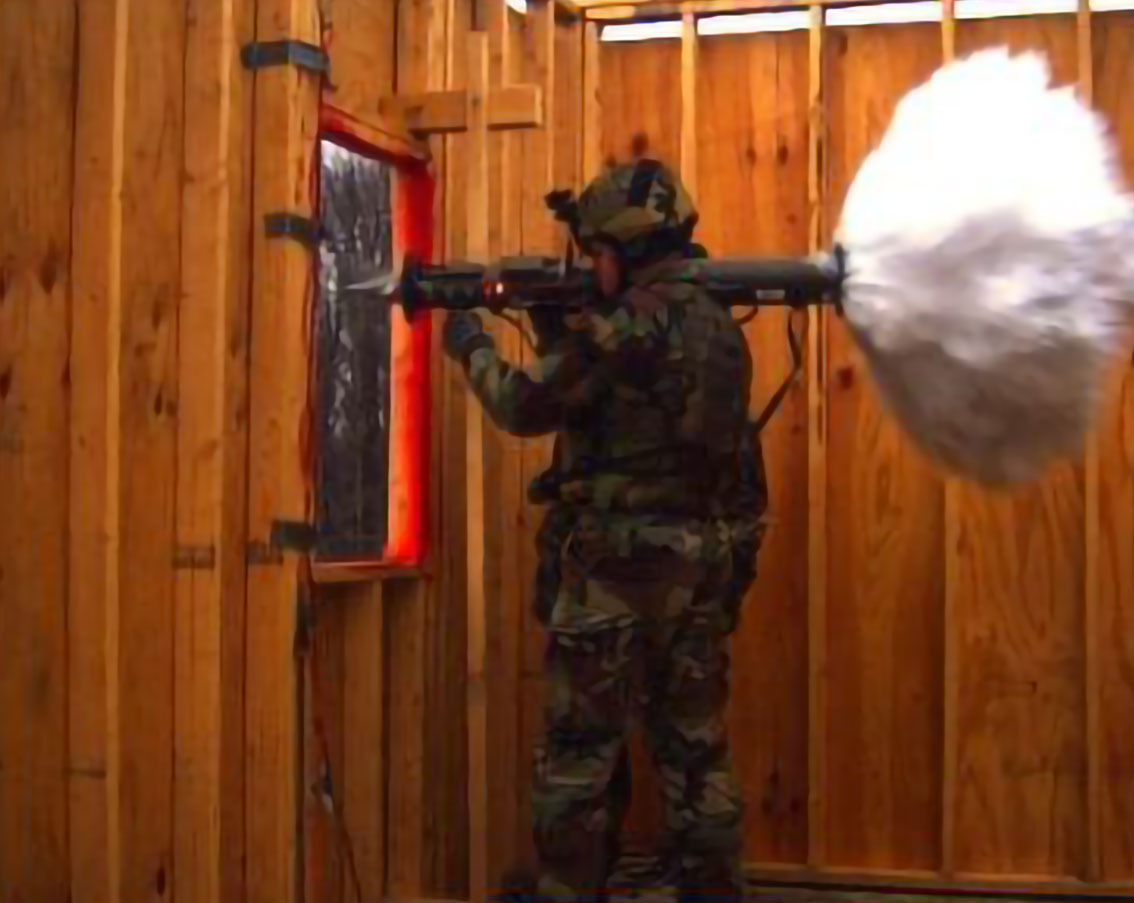
The AT4 Combined Space is fired in the open. (Photo courtesy of PM CCS)
Project Manager Close Combat Systems takes the next generation shoulder launched munition in a new direction.
by Ken Schulters, Mark Bailey, Michael Franz and Styles E. Underwood, Jr.
As early as World War I, commanders faced a dilemma when deciding which shoulder-launched munitions (SLMs) to carry into battle: anti-armor, anti-structure, or both. This dilemma directly affects force load-out—the equipment a group of soldiers (company, platoon, squad, or fire team) must elect to carry when they deploy—Soldier survivability and, ultimately, mission success. Additionally, the current, multiple SLM configurations entail expanded training, logistics, life cycle management and cost requirements. In alignment with the Army modernization priority for Soldier lethality, Project Manager Close Combat Systems (PM CCS) within the Joint Program Executive Office for Armaments and Ammunition located at Picatinny Arsenal, New Jersey, has been charged with eliminating this dilemma by providing a new shoulder-launched munition capable of engaging multiple target categories.
An integral part of the PM CCS portfolio, such munitions have been the dominant effective weapon against armored vehicles and fortified structures used by the U. S. Army, Marine Corps and Special Forces. These munitions are designed to defeat or incapacitate adversaries within earth and timber bunkers, adobe, double reinforced concrete, triple brick wall structures, and light armored vehicles. Although the SLM has proven to be a weapon of choice, there is a major challenge that Soldiers face—no single SLM configuration is capable against all of these target sets. The solution—the XM919 Individual Assault Munition—will be lighter, able to be fired from within an enclosure, and capable of defeating each of the target sets. It will contribute to survivability by enabling the Soldier to engage targets from protected positions without being exposed to enemy fires and effects. This disposable shoulder launched munition will combine the capabilities and replace the M72 Light Anti-Armor Weapon, M136 AT4 Light Anti-Tank Weapon, M136A1 AT4 Confined Space, and M141 Bunker Defeat Munition in the arsenal.
In addition to addressing the technical challenges, PM CCS will address the underlying SLM acquisition process. Historically, SLMs have been procured via sole-source contracts to meet specific, narrow mission requirements. This approach has resulted in limited competition, diminished government data rights, and multiple SLMs in the Army’s inventory each with unique logistics and training requirements. PM CCS will pursue full and open competition for the XM919 production contract with government data rights to support future competitive procurements.

BOOM: Earth and timber bunker before the SLM detonation at the Redstone Test Center, Redstone Arsenal, Alabama. Previous iterations of SLMs can only defeat one or two types of targets, a limitation PM CCS wants to overcome. (Photo courtesy of Redstone Test Center, Redstone Arsenal, Alabama)
CHALLENGE
The infantry warfighter community continues to request enhancements to improve Soldier survivability while increasing combat effectiveness and lethality. Lt. Col. Christopher Kennedy, chief of the Lethality Branch, Maneuver-Capabilities Development and Integration Directorate, is responsible for the evolution and integration of SLM capabilities to meet this challenge. “The current suite of SLMs are optimized for specific target sets. While this served its purpose in the past, the future fight requires the ability to defeat our adversaries across a wide spectrum of environments with one munition,” he said.
How can the U.S. Army fill the capability gap of a single shoulder-launched munition used to defeat multiple targets, and thereby eliminate the commander’s dilemma of having to choose the correct SLM to address the potential threat? For example, the M141 Bunker Defeat Munition provides Soldiers with the capability to defeat the protective cover provided by masonry structures, earth and timber bunkers, and field fortifications. However, they can only be fired in an open environment, such as a trench lines or streets exposing Soldiers to enemy fire. Conversely, the M136A1 AT4 Confined Space provides Soldiers the capability to only defeat light armored platforms but can be safely fired from within an enclosure or covered and concealed position, eliminating Soldier-to-enemy fire.
However, the XM919 Individual Assault Munition must provide a capability to penetrate and deliver incapacitating effects behind standard building walls (triple brick, reinforced concrete and adobe), lightly armored vehicles, and field fortification or bunker fighting positions. The munition must also support the close fight in urban and complex terrains (fired from within an enclosure). Ultimately, it needs to be lightweight, compact, highly lethal, easy to safely operate and readily transported with Army forces anywhere on the globe.
In addition to the technical challenges, SLMs have been procured through sole-source contracts. With limited to no competition and a lack of data rights, which puts the government at a disadvantage from a negotiation perspective. This significantly impacts the munition’s unit cost for both the tactical munition and the training devices. The question is, how does the government shift the paradigm from sole source to a competitive procurement and still acquire a technically superior munition system (tactical and trainer) for a reasonable price?

AFTERSHOCK: The earth and timber bunker after shoulder-launched munition detonation at the Redstone Test Center, Redstone Arsenal, Alabama. (Photo courtesy of Redstone Test Center, Redstone Arsenal, Alabama)
THE APPROACH
For years if not centuries, target characteristics such as earth and timber, concrete and brick have not changed. However, a single munition capable of defeating these targets has not been developed or identified. Industry’s approach has always been to meet the specific needs of the Soldiers rather than developing a more versatile weapon. In line with the Army Futures Command philosophy of creating “a continuous transformation of Army modernization in order to provide future warfighters with the concepts, capabilities and organizational structures they need to dominate a future battlefield,” PM CCS engaged the technical community, industry and the user community through requirement and technology developments, industry capability assessments and open dialogues.
To best influence the requirements for a single shoulder-launched munition and modernize the state of technology, PM CCS approached the solution from two directions. First, the U.S. Army’s Combat Capabilities Development Command Armaments Center (DEVCOM-AC) at Picatinny Arsenal, was tasked to develop key elements of the weapon to close the capability gaps at the munition level. A military operations in urban terrain Army technology objective was funded with the goal of integrating component technologies into a technology readiness level (TRL) 6 multipurpose shoulder-launched munition.
The goal was to develop a system weighing less than 15 pounds with fire-from-enclosure capability. The objective was to achieve the lethality capabilities identified in the Individual Assault Munition’s capabilities development document. While this effort primarily focused on integration, it significantly leveraged 10 years of warhead development. The overall effort enabled the government to significantly improve its shoulder-launched munitions design competency, launch capability, target effects and system optimization modeling. The urban combat Army technology objective effort resulted in a TRL-6 government-owned technical data package, proving that technologies exist to achieve the requirements with a single munition.
Second, PM CCS worked with the user community and U.S. Army Maneuver Capabilities Development and Integration Directorate, to develop an extensive Individual Assault Munition capability development document. This integrates the combined capabilities of several configurations with the need for Soldiers to carry just one into the field. Added benefits to this approach include Soldiers training on one configuration, making inventory and logistics significantly easier to manage.
“Our innovative acquisition approach to pursue mature technologies eliminates costly development efforts, reduces overall life cycle costs, and rapidly fields improved capabilities to our joint warfighter,” said Col. Russell Hoff, project manager for CCS. PM CCS found a balanced approach to the XM919 Individual Assault Munition program that eliminates government development costs and schedule. The government technical experts are working with industry to meet our Soldiers’ needs to rapidly produce a more versatile and effective munition.
MOVING OUT
Based on the results of the urban combat technology objective, coupled with an approved capability development document, PM CCS is in the process of acquiring a mature, production-ready XM919 Individual Assault Munition candidate from industry. The program is proceeding with a multipronged approach in order to best meet the Soldier’s requirements while being mindful of costs and schedule. In 2020, PM CCS performed market research to determine the maturity of the shoulder-launched munition industry as compared to the Individual Assault Munition’s capability development document requirements. Based on the results, three mature munition configurations were procured for assessment and user feedback through Soldier touchpoints such as user jury events. These assessments are not intended to select a final candidate, but to establish an industry technology maturity baseline as it relates to the capability development document requirements.
Because of pandemic constraints, PM CCS conducted an XM919 Individual Assault Munition virtual industry day in the third quarter of fiscal year 2021. The event was successful providing guidance on the government’s acquisition strategy and insight for industry to focus their internal research and development investments towards addressing the Individual Assault Munition requirements. The government also offered the technical data package developed under the urban combat effort for industry to leverage in part or its entirety. This event was a critical first step to generate industry interest in providing a solution.
A second industry day is planned for the third quarter of fiscal year 2022 to provide program and requirement updates before the XM919 Individual Assault Munition full and open production contract request for proposals release. It is the program’s intent to acquire the XM919 Individual Assault Munition data rights. This will reduce the government’s dependency on a single contractor and allow for more flexibility in modifying the munition to meet future requirements. This is a major paradigm shift in the history of SLM procurements.

INSIDE AND OUT: The XM919 Individual Assault Munition (IAM) will be able to be fired from within an enclosure and capable of defeating multiple target sets. Previous SLMs could only defeat one target set and had to be fired under specific conditions—such as out in the open. Here, the AT4 Confined Space is fired from an enclosure. (Photo courtesy of PM CCS)
CONCLUSION
The XM919 Individual Assault Munition will provide a modernized single munition with a multitarget capability to penetrate and deliver incapacitating effects behind standard building walls, field fortification and bunker fighting positions, and lightly armored vehicles. The lightweight, compact SLM munition will provide a highly lethal capability delivered in a safe, easy to operate, and readily transportable weapon configuration with Army forces to anywhere on the globe. Finally, it will significantly reduce the overall SLM cost, training, logistics and life cycle management requirements.
PM CCS is reducing the commander’s burden of having to decide which SLMs to carry into battle by providing a single fully integrated munition to address potential threats. The paradigm shift of openly competing a shoulder-launched munition contract in lieu of a sole-source arrangement provides the government more flexibility to negotiate better pricing. Additionally, the government strategy of acquiring a mature SLM system eliminates the development cost and provides this capability to the Soldier more quickly.
For more information, contact Ken Schulters, XM919 project officer at ken.r.schulters.civ@mail.mil or go to the PM CCS website at https://go.usa.gov/xFrE2.
KEN SCHULTERS is the Product Director Combat Armaments and Protection Systems project officer. He has over 21 years of civil service with the U.S. Army providing engineering and program management in RDT&E and Acquisition for Small and Medium Caliber Munitions, Lethal and Non-Lethal, Shoulder Launched Munitions and Terrain Shaping systems. He has a B.S. in mechanical engineering The City College of New York and is DAWIA Level III certified in program management and systems engineering.
MARK E. BAILEY is a Booz Allen Hamilton contractor supporting PM CCS. He has over 33 years of civil service with the U.S. Navy supporting RDT&E, acquisition and program management on torpedoes, Surface Ship Torpedo Defense, Rolling Airframe Missile Systems, Counter Narco-Terrorism, and Hyper Velocity Projectiles. He has a B.S.in electrical engineering from the South Dakota School of Mines and Technology, a master’s degree in public administration from Indiana University and was DAWIA Level III test and evaluation certified.
MICHAEL FRANZ is a DEVCOM Armaments Center mechanical engineer supporting Shoulder Launched Munitions. He has over 19 years of civil service with the U.S. Army supporting RDT&E, acquisition, and technical management on Shoulder Launched Munitions, and their major subsystems including fusing, warheads, launcher platforms, propulsion and testing. He has a B.S. in mechanical engineering from the New Jersey Institute of Technology, is Level III certified in Systems Planning, Research, Development, & Engineering (SPRDE) – Systems Engineering, Level I certified in SPRDE program management, and is an Army Acquisition Corps Member.
STYLES E. UNDERWOOD, JR., Nemean Solutions LLC, is the senior capabilities development analyst, and expert for shoulder launched munitions. He has over 41 years of military experience with combat requirements development, training development, doctrine coordinator and new equipment training on both heavy and medium anti-armor missile systems and shoulder-fired rockets. He has a B.A.S. in resource and technology management from Troy University.







